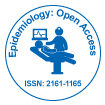Epidemiology of Waterborne Diseases is Relevant to the Classification and Prediction of River Network Ephemerality
Received Date: Nov 01, 2022 / Published Date: Nov 30, 2022
Abstract
The hydrology and ecology of hosts, vectors, and parasites combine to determine how aquatic diseases spread, with the long-term absence of water serving as a strict lower constraint. However, the relationship between spatio-temporal patterns of hydrological ephemerality and the spread of waterborne diseases is unclear and challenging to explain. To describe, categorise, and predict river network ephemerality in a spatially explicit framework, it is consequently necessary to use restricted biophysical and hydroclimate data from places with otherwise sparse data. Here, we create a brand-new method for classifying and predicting large-scale ephemerality that is applicable to epidemiology, maintains a mechanistic connection to catchment hydrologic processes, and is based on monthly discharge data, water and energy availability, and remote-sensing measures of vegetation. In particular, in light of the background of we extract a useful collection of catchment covariates from Burkina Faso in sub-Saharan Africa, including the aridity index, Budyko framework annual runoff estimation, and hysteretical relationships between precipitation and vegetation.
Citation: Jose K (2022) Epidemiology of Waterborne Diseases is Relevant to the Classification and Prediction of River Network Ephemerality. Epidemiol Sci, 12: 471. Doi: 10.4172/2161-1165.1000471
Copyright: © 2022 Jose K. This is an open-access article distributed under the terms of the Creative Commons Attribution License, which permits unrestricted use, distribution, and reproduction in any medium, provided the original author and source are credited.
